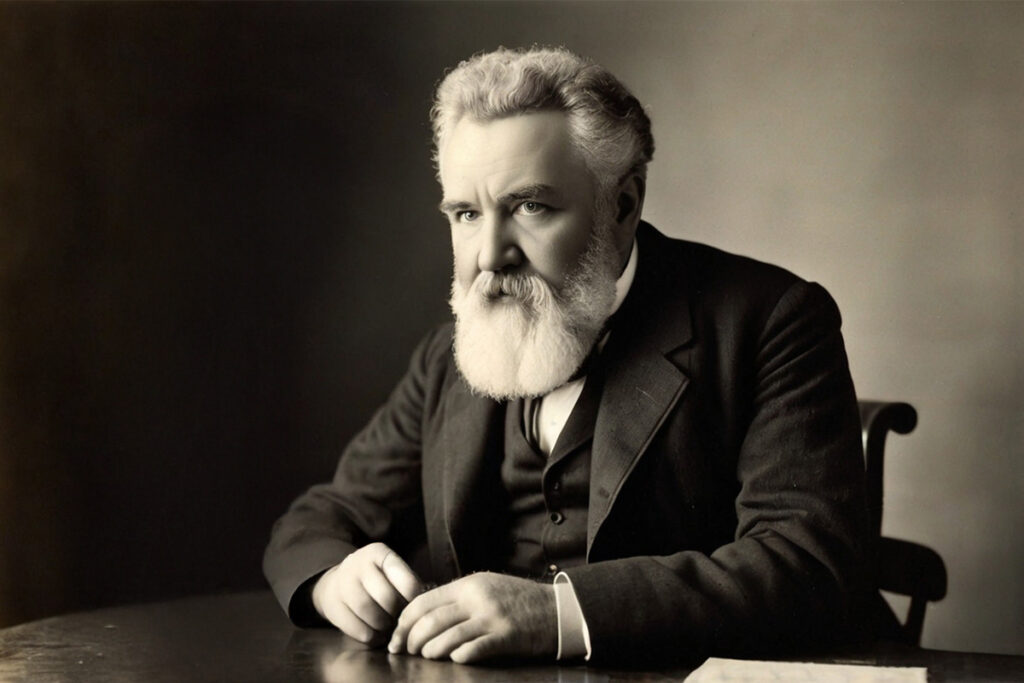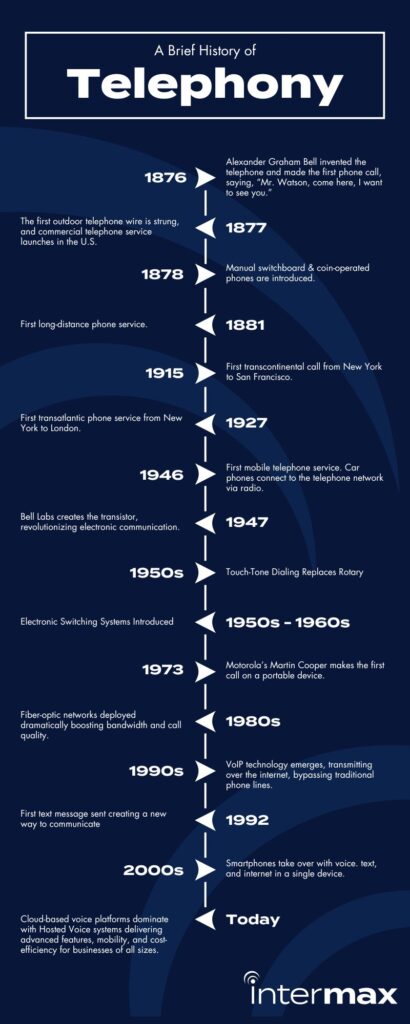
A Brief History of Telephony
Today, we carry powerful communication tools in our pockets, and it’s easy to take texting, video calls, voicemail for granted when we can access everything the internet has to offer right in the palm of our hands. All made possible by the modern marvel we call the telephone. But how did we get from candlestick phones to high-speed voice over the internet?
To better appreciate the future of communication, let’s take a quick trip to the past. Here’s how telephony evolved from wires and switchboards to fiber and hosted voice and how it’s shaping the future of communication.

It All Started with a Bell (1876)
In 1876, Alexander Graham Bell famously made the first telephone call, saying, “Mr. Watson, come here, I want to see you.” That moment sparked a revolution. Unlike the telegraph, which sent messages in Morse code, the telephone transmitted actual voice over a wire allowing people to speak in real time, even miles apart. Just one year later, the first outdoor telephone wire was strung, and commercial phone service began in the U.S.
The early phones were hardwired to one another. No dialing, no switching—just a direct line between two points. This was revolutionary, but not scalable.

Enter the Switchboard (1878–1920s)
As demand grew, so did the need for a way to connect multiple callers. In 1878, the first manual switchboard and coin-operated telephone were introduced. These early systems required operators to manually connect calls. Switchboards, operated mostly by women, became the heart of the telephone network. You’d lift the receiver, an operator would answer, and they’d physically plug your line into another to make the connection. An innovation that enabled more users to join the growing network.
By 1881, long-distance service was available, and in 1915, the first transcontinental call traveled coast-to-coast from New York to San Francisco. A major leap came in 1927, when transatlantic telephone service connected New York and London for the first time.
Eventually, rotary dial phones and automatic switching systems took over, allowing users to dial numbers directly without operator assistance. This laid the groundwork for the vast telephone networks we rely on today.
Long-Distance, Area Codes & The Rise of the Network (1930s–1960s)
By the mid-20th century, telephone lines stretched coast-to-coast and even across oceans. The introduction of area codes and long-distance service made it easier and more affordable to call anywhere.
In this era, “Ma Bell” aka The American Telephone & Telegraph Company (AT&T) dominated the industry, and innovation continued. Touch-tone dialing replaced the rotary dial, and new technology sped up switching, routing, and call quality.

Digital Disruption & Mobile Moves In (1970s–1990s)
In the 1970s and 1980s, digital technology began to reshape communication. Analog signals were replaced by digital ones, improving clarity and paving the way for computer-based calling features such as voicemail and call forwarding.
In 1973, Motorola engineer Martin Cooper made the first handheld mobile phone call, paving the way for portable communication. By the 1980s, the introduction of fiber-optic cables allowed telephone networks to transmit voice and data at speeds and capacities that had once seemed impossible.
These innovations laid the foundation for the most transformative shift yet: the internet.
In the 1990s, Voice over Internet Protocol (VoIP) emerged, allowing voice data to travel over the same networks used for email and the web. This leap unshackled telephony from copper lines and physical hardware, making it more flexible and scalable than ever before.
Mobile phones became smaller, more affordable, and more accessible, making it possible to call from virtually anywhere. In 1992, the first SMS text message was sent, introducing a new, more immediate way for people and businesses to stay connected.

The Internet Changes Everything (2000s–Today)
The biggest disruption? The internet. With the rise of broadband and Wi-Fi, we no longer need traditional phone lines to make a call. Voice over Internet Protocol (VoIP) emerged, turning voice into data and allowing calls to be made over the internet instead of copper wires. This shift gave homes and businesses new levels of flexibility, advanced features, and often lower costs.
By the early 2000s, smartphones brought voice, messaging, data, and applications all together in a single mobile device. Communication became not just portable, but fully integrated.
Today, the move to cloud-based voice platforms has accelerated. Businesses rely on flexible, feature-rich systems that support modern workflows, from remote access and voicemail-to-email integration to advanced call routing and conferencing capabilities.
At Intermax, our Hosted Voice service is a modern VoIP solution built for small businesses and enterprise clients alike. It delivers crystal-clear calls, seamless collaboration tools, and the reliability that Idaho and Washington businesses depend on without the need for on-premise PBX hardware.
What’s Next? The Future of Telephony
Telephony continues to evolve. Artificial intelligence is now being used to transcribe voicemails, filter spam calls, and enhance customer service. At the same time, 5G and fiber-optic networks are pushing speed, reliability, and mobility even further.
At Intermax Networks, we’re proud to help businesses across the Inland Northwest modernize their voice systems, leveraging cloud-based technology that scales with your team, supports productivity from anywhere, and keeps you reliably connected.
From switchboards to smartphones, telephony has come a long way, and the pace of innovation isn’t slowing down. Whether you’re exploring cloud voice solutions or just curious about how far we’ve come, Intermax has the tools, support, and expertise to keep you ahead of the curve.
Find Connection with Intermax
Locally owned and operated since 2001, we’re proud to offer high-speed wireless internet, fiber, voice services, and more to thousands of residential and commercial customers.
Headquartered in Coeur d’Alene with offices in Spokane, Seattle, Sandpoint, and St. Maries, Intermax is the locals’ choice for reliable service in hard-to-reach places.
Our friendly support team is here to answer any questions you may have. Visit Intermax, or call us at (208) 568-7979, today!





